"I'm not surprised, not everything lasts ~"
Hello friends. It’s time to begin the long, slow process of catching up my LJ. More later on life and boys (there aren’t many) and work and family and hobbies… but for now, a look back to the saving grace of early November: I spent eight days and seven nights in Ireland.
I won’t dwell on my delayed connecting flight and exhausting night spent at Chicago-O’Hare, except to say that it was the night the Cubs won the World Series. That was one loud airport bar and one manic, sleep-deprived Day 1 in Dublin.
But I was there on a mission to revel in the 1916 Easter Rising centennial, which meant touring my favorite cemetery, Glasnevin.
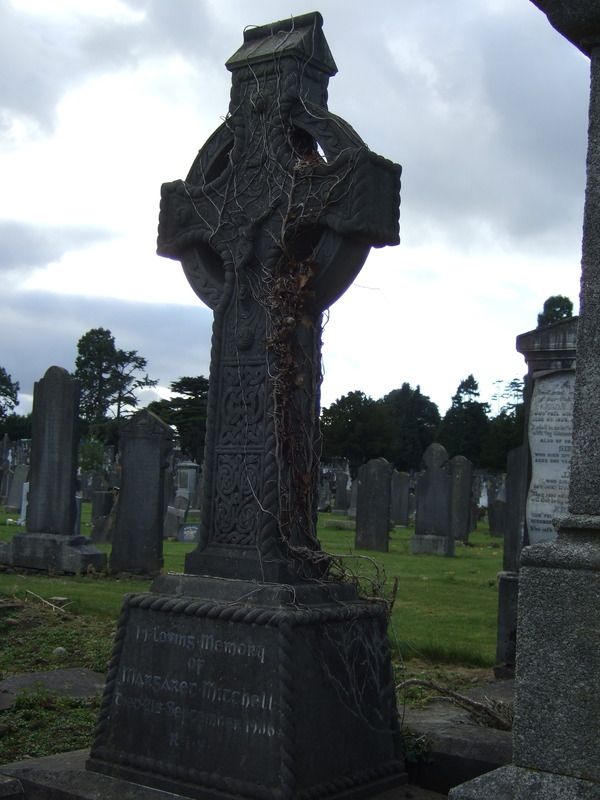
1.5 million people are buried here, from Taoiseach Eamon de Valera and beloved martyr Michael Collins… to an often-unnoticed corner in the far side that holds rows of stillborn children. They’re in what used to be a forgotten, dark corner full of Catholic taboo, but less so now. A popular, sardonic curator was found hanging from one of the old, green trees in a far corner a couple years ago. This is a sad place in most ways.
After the revolutionary tour I made an effort to explore all thoses far sides of the place that I didn’t make it to in 2008. You could spend hours there and miss plenty. I’m also happy to report that what used to be a rinky-dink flower stand at Glasnevin is now a full-blown interpretive center and crematorium (+ rinky-dink flower stand).

The Winding Stair was my second choice for dinner. I’m so glad my first choice was booked solid. The Winding Stair is up said stairs and overlooks the River Liffey. I sat by myself in the back, next to an old heater at a table that rocked. The waitress liked me and my simple order and low maintenance. The food is a great example of Irish cuisine: bland colors, unspectacular presentation, but the most comforting blend of dairy and warm spices and vanilla’d fruits. I had chicken and root vegetables and plum sponge cake with cinnamon crumble and spiced custard and cream.
I did lots of shopping in Dublin. I tasked myself with finding Rachel an adorable wool cape (it had buttons!) and bought myself a cute green hat, among other family presents. Walking along the Liffey on Day 2 I happened to see a sign for a National Gallery exhibit called Creating History. Are you kidding me?! Four free gallery rooms on “Stories of Ireland in Art.” I asked the interpreter if it was a coincidence or a curatorial decision that there were no depictions of de Valera in the whole exhibit (he basically was 20th century Irish politics), and learned that his absence was because most of the paintings were foreign. Good point. No one in Britain or the U.S. is more interested in de Valera, who lived plenty long to see his legacy complicated, than they are in Michael Collins, who lived more radically and was killed young.
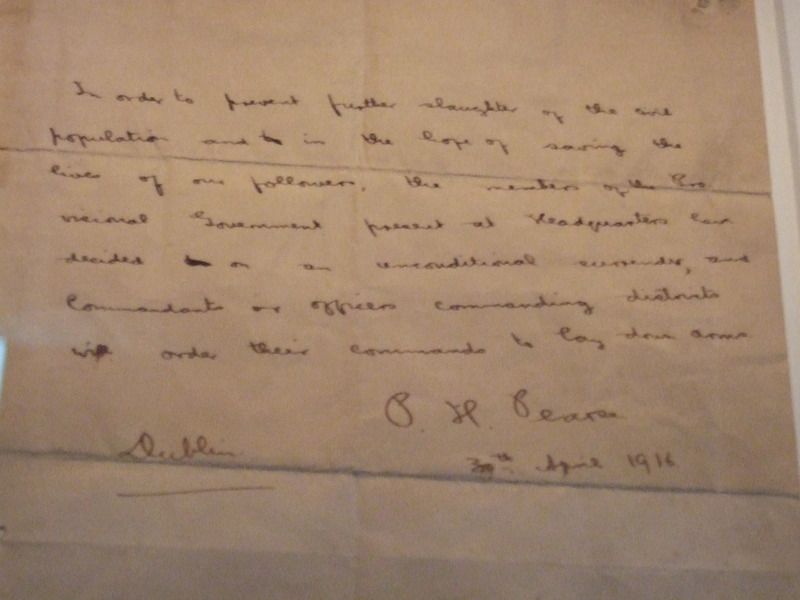
The highlight of Dublin, and nearly the whole trip, was the Centennial exhibit housed in the General Post Office - in other words, in the footprint of the Easter Rising itself. It was a fantastic exhibit. A combination of low and high tech, of colorful replicas and aging artifacts. Most important was a small glass case, with no spectacular signage, that held this. THE surrender document written my Padraig Pearse. As a reminder, the republicans botched the 1916 rebellion, and then the British botched their own victory over the republicans. This surrender document led to executions, which led to the swing in public opinion which led, after a torturous civil war and much feet-stamping from England, to independence.
I DIDN’T EVEN KNOW THIS LETTER WAS GOING TO BE THERE, or that this letter was slated to go off display and up for public auction less than a month after the week I visited. Of course the real tragedy is that the state wouldn’t raise the money to keep the letter in Ireland; it’s widely assumed now that some rich American will buy it, never to be put on public display again. We’ll see.
I took a train the next day to Killarney, a charming four-intersection town and a stunning national park. I was tired and a little anxious about getting to where I needed to go, but loved every second of the three-hour train ride through the country and farmland. After grabbing a lunch to go near the Killarney train station, I waited for a Muckross Park Hotel employee who had crazily generously offered to come pick me up from the station. I sat alone in his shiny van and smiled out the window at the Killarney streets I’d been past eight years ago.
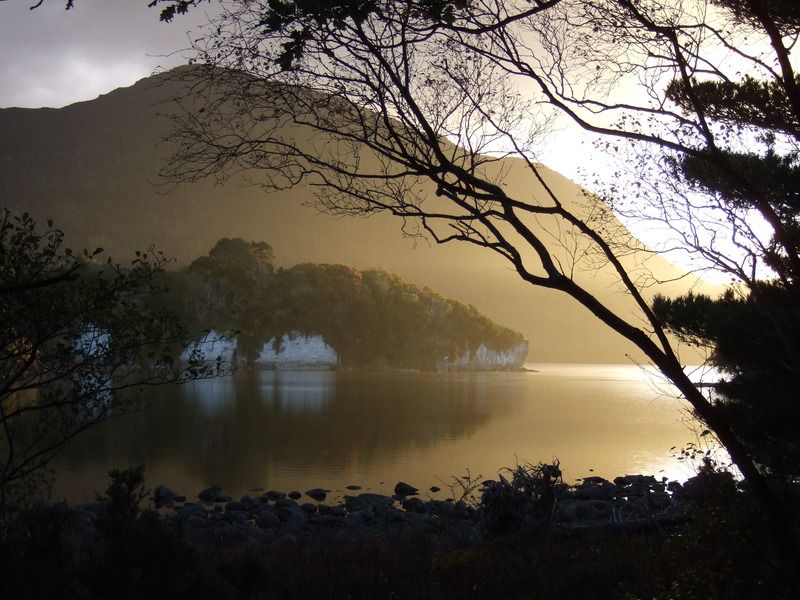
The first thing I did after checking in to my hotel was cross the street and walk through the gates of the national park. That’s how close I was. It was a twenty-minute walk to the Muckross House visitor’s center, which I bypassed except for a small rock garden. Horse carriage drivers were parked outside and asked me three times if I wanted a ride. They seemed to like hearing me say no thank you.
Then I chose a path away from the cars and diners, and another path, up a low cliff and down the other side. It got very quiet very quickly, and stayed that way. I came to this small lakeshore and, listening to the quiet of wind and twig rustle, realized that I had arrived at the feeling I’d traveled all this way for. It was just a lake, just a park I’d seen before, but it was a bud of mental health I hadn’t nurtured for a while. So I pulled out my squashed O’Brien’s sandwich, sat on a rock, and committed the moment to memory. It took eight years but I fucking made it. Air in the trees, cloudlight on the water.
There was no one in sight; it was 3:30pm on a cloudy November afternoon. It began to rain and on the way home the older of the horse carriage drivers clopped up alongside me on the path and said down to me “up you go, miss.” So with an umbrella in one palm and his outstretched hand in the other, I balanced a foot on the hub of a huge wheel, toe lodged between the two upmost spokes, and hauled up to sit next to him behind a beautiful brown and cream horse. Now that he was off-work, and I wasn’t a potential customer, nothing pleased him more than to do something nice for me. He dropped me off in front of the hotel and said good-bye.
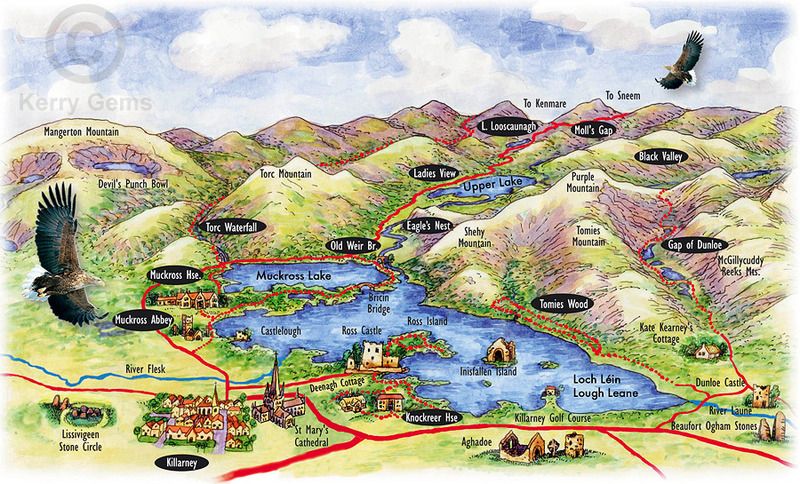
My hotel was a short way across the road from Muckross Abbey, steps outside of the park. 5-star! On a rock-bottom discount because who’s going to the national park in November? Solo travelers with two weeks before their new job starts, that’s who. Anyway, the hotel staff are brilliant at what they do. Beautiful triple-level tea trays with breakfast every morning. Everything perfect and trained. I saw tremendous pride there.
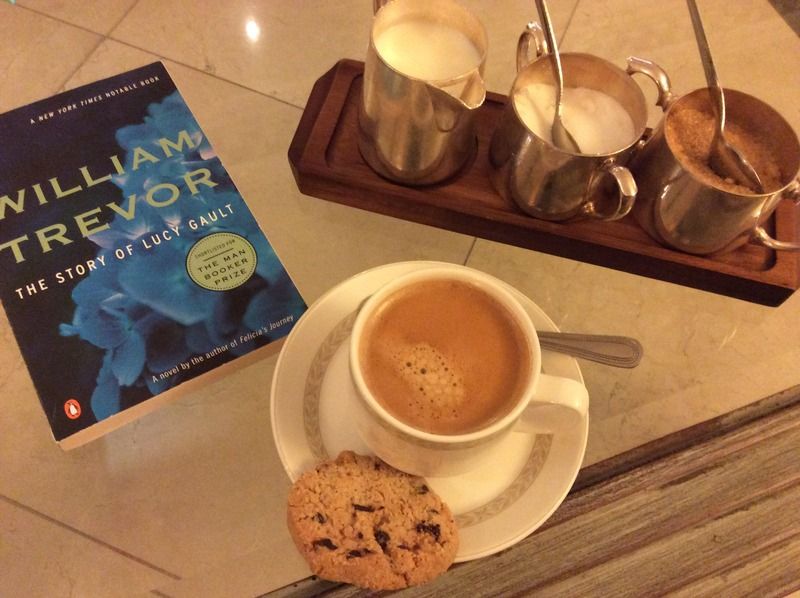
One day I was sitting alone at a glass coffee table on the bottom floor, watching hotel life, and an employee who had welcomed me when I first arrived appeared out of nowhere and asked if I’d like some tea or coffee. Always, good sir, and thank you.
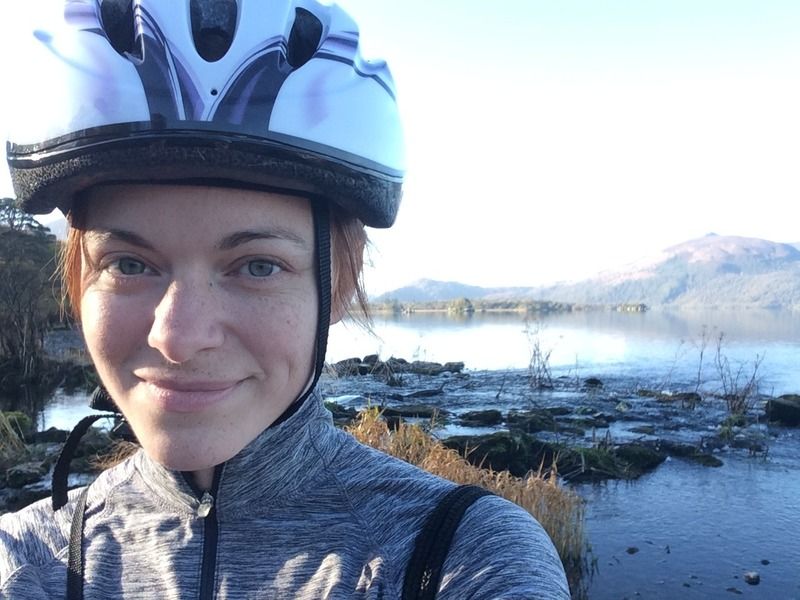
The second day at the park came with better weather, which was lucky because I was scheduled to use one of the hotel bikes and tool around the middle lake. I took all the detours I could find and rounded out about 8 miles of biking, 2 or so of hiking. For those who don’t know, I am not a biker, and walked my bike up more than one of the steep hills, but damned if I was going to miss ONE VISTA in the middle lake area. I saw an abandoned stone home, the Old Weir Bridge, and the “Meeting of the Waters” where all three lakes meet in a soft rush of water, in cross-currents from all directions in the shade. I met a grandfather and grandson there, locals who were passing the school day while the teachers were on strike. They loved talking to me, wanted me to know everything they could think of about the park, and to be safe travelling alone, cheers.
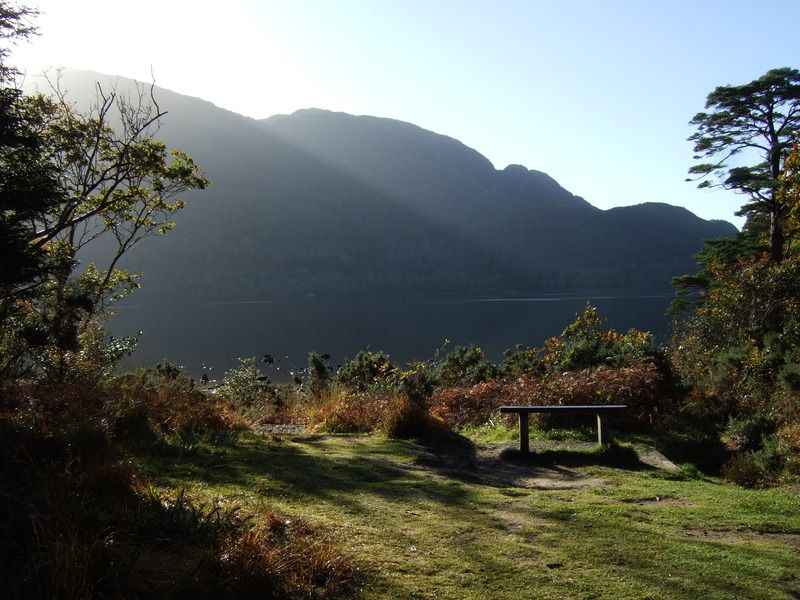
For the most part though, I really did have the park to myself. This was my average stop-off, bike on the ground and smiling to myself with a baggie of beautiful glazed pastries from breakfast. I could sing.
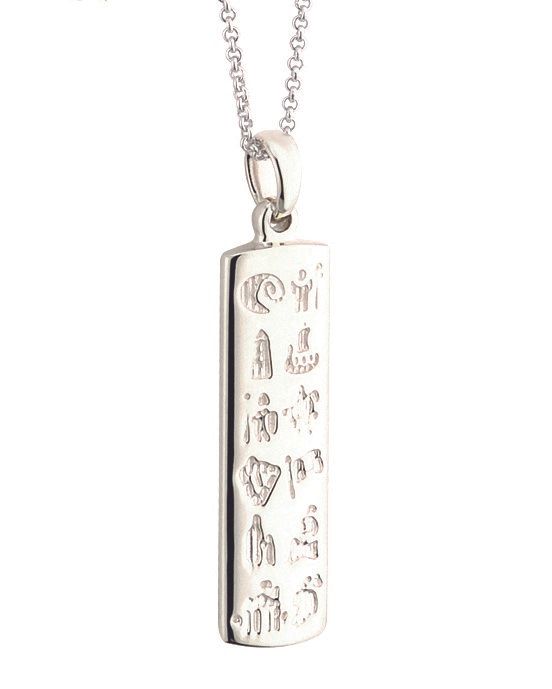
On the third day, in the rain again, I went in to Killarney town and had a chicken pot pie from an unassuming place behind a tertiary street. And I shopped! It was so much fun, looking for Kinder Bueno and a present for special folk and whatever the flip it pleased me to gift myself. Above is the stock photo for my celebratory “me” purchase. It’s sterling silver with representative etchings of Irish history. The Celtic circle of life, St. Patrick, a monastic tower, ghostly famine figures, even a burning GPO on the bottom left. Partitioned Ireland on the bottom right. You guys, this NECKLACE.
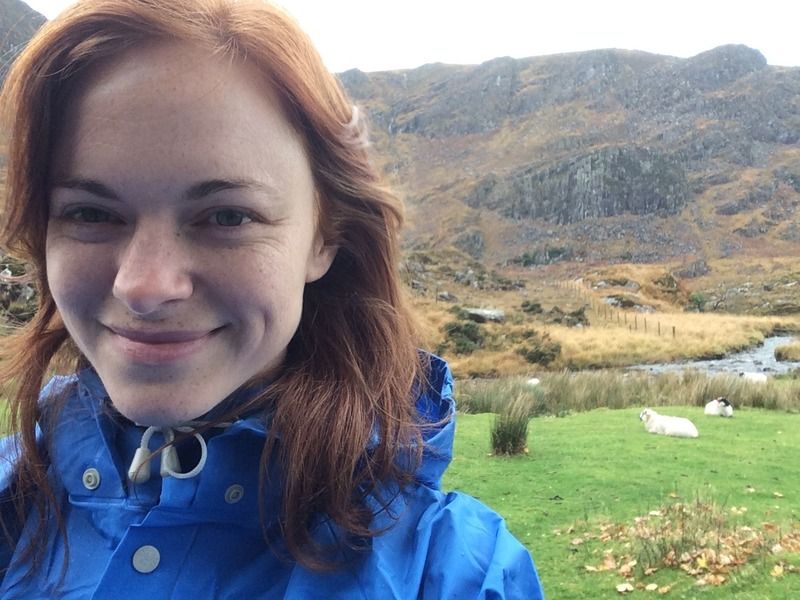
On my last full day in Killarney I tried mighty hard to book a boat and horse tour through the Gap of Dunloe, out of walking or biking distance but very much of interest. The tour folks had put me off for two days and then finally called the hotel to inform me they weren’t running the tours that day. Well. Okay. In their defense the forecast said on-and-off rain. But I’d flown here to do the park, so the park must be done. I called a taxi. I had a pretty strong sense of whether the average Irish man likes me by this point, and the answer was yes. He agreed to drop me off at the mouth of the gap and come back in three hours.
I started on the north end of the gap, walking south past a couple taverns and country houses, which give way to farmland not far in. For a while it’s a thin, winding road through the last of modern civilization. To be sure, this route gets plenty of hikers and some cars during the year, but in November when the weather’s bad? No. For a while it was just me and the sheep and cows and horses. And then it was just me.
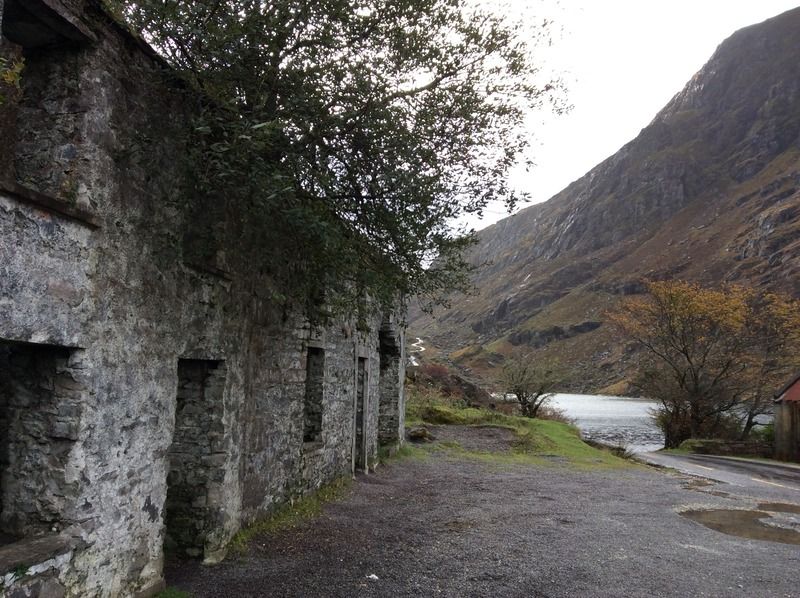
Before I got to the deepest point of the gap I found this 19th century building, which I learned later was a burned police barracks. This is a great piece of history to have stumbled upon. Small police forces were common enough toward the end of the century, especially in a gap like this that links remote places like Killarney and Sneem. But it’s no wonder it fell out of use, probably, because by the 1920s it wasn’t worth keeping a constabulary presence in the middle of nowhere; they were easy targets for the early IRA and who knows who else. I can’t claim to know the circumstances under which this place burned, but I’m not remotely surprised it was left to fall apart.
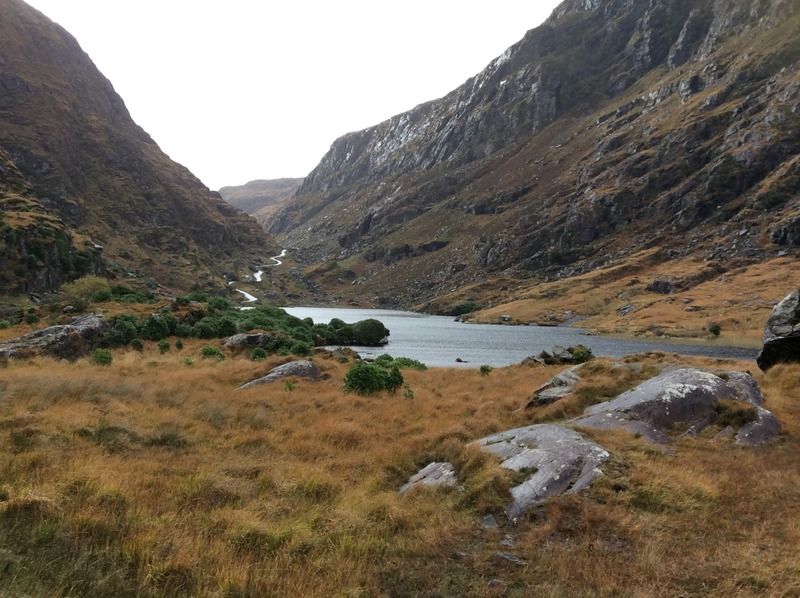
The Gap of Dunloe was a genuinely new experience. The lake, the woods, the waterfall, the town are all beautiful and you could live here and never step through every yard of it… but I had never stepped in the gap before. To do it in near isolation was special. If I had fallen, no one would have seen. When it began to rain, weighing down my sneakers and turning my walking jeans into skinny jeans, it didn’t matter what I looked like. Eventually even the small farming lots disappeared and it was just me and the upward path, and the peaks above. A creek formed and went underground. The wind whipped across the ponds. Rain against the hood of my coat. The thinnest waterfalls I’d ever seen fell from higher up than I could discern. At any point, you could hear water from at least three distinct places. The wind pushed me, like it had an opinion on the matter. Honestly the weather was dismal and just about perfect. I was alone and so happy.
I made it to the Black Valley, looked out a little intimidated over the descent into the white fog, wiped my dripping wet hair out of my dripping wet face, and turned around. I had less than an hour to meet my cab. But I still found another 30 seconds to commit the happy solitude and the greyness to memory. Purple Mountain’s waterfalls to one side and McGillycuddy Reeks to the other.
My smiling cab driver said he’d almost come back as soon as the weather had turned bad; he’d thought for sure he’d get a call from me that I’d changed my mind. He took me to my hotel; the Gap was done. I regrouped in my room and took one more walk to the park lake, to say good-bye to the week. Soon it got dark.The wetness and night made the smell of the ferns acute.
Early next morning at the Killarney station, I asked a local if they’d let me on an early bus with my original ticket - he told me probably, wandered off, and then came back to tell me to flag him down if they gave me any trouble. Then he must have decided he could do better and sat close by, a respectful distance, wanting to talk about his ancesters and my centennial fun. He wanted to know what I thought of de Valera; a fucking loaded question in Ireland. It turns out he actually owns one of the remaining seven original proclamations from 1916 (all under glass). He told me I could borrow it if I ever needed to. What! We traded e-mails.
Train, Bus, Dublin airport in plenty of time. Unsurprisingly the customs guy was the one Irishman who didn't trust me. Why was I here in November? Was I meeting friends? Why was I traveling alone?
Because I just got a job, that's why. Because I've wanted to see this place again for the past eight years. Because right now I deserve whatever piddly week of travel I can pull off. In a way, friends, this trip capped off several up and down years that I never shared online or with anyone, really. I'll see what I can do to fill some of it in.
Also my Irish phone from 2008 apparently doesn’t work anymore so it’s a good thing nothing went wrong. Later days.
I won’t dwell on my delayed connecting flight and exhausting night spent at Chicago-O’Hare, except to say that it was the night the Cubs won the World Series. That was one loud airport bar and one manic, sleep-deprived Day 1 in Dublin.
But I was there on a mission to revel in the 1916 Easter Rising centennial, which meant touring my favorite cemetery, Glasnevin.

1.5 million people are buried here, from Taoiseach Eamon de Valera and beloved martyr Michael Collins… to an often-unnoticed corner in the far side that holds rows of stillborn children. They’re in what used to be a forgotten, dark corner full of Catholic taboo, but less so now. A popular, sardonic curator was found hanging from one of the old, green trees in a far corner a couple years ago. This is a sad place in most ways.
After the revolutionary tour I made an effort to explore all thoses far sides of the place that I didn’t make it to in 2008. You could spend hours there and miss plenty. I’m also happy to report that what used to be a rinky-dink flower stand at Glasnevin is now a full-blown interpretive center and crematorium (+ rinky-dink flower stand).

The Winding Stair was my second choice for dinner. I’m so glad my first choice was booked solid. The Winding Stair is up said stairs and overlooks the River Liffey. I sat by myself in the back, next to an old heater at a table that rocked. The waitress liked me and my simple order and low maintenance. The food is a great example of Irish cuisine: bland colors, unspectacular presentation, but the most comforting blend of dairy and warm spices and vanilla’d fruits. I had chicken and root vegetables and plum sponge cake with cinnamon crumble and spiced custard and cream.
I did lots of shopping in Dublin. I tasked myself with finding Rachel an adorable wool cape (it had buttons!) and bought myself a cute green hat, among other family presents. Walking along the Liffey on Day 2 I happened to see a sign for a National Gallery exhibit called Creating History. Are you kidding me?! Four free gallery rooms on “Stories of Ireland in Art.” I asked the interpreter if it was a coincidence or a curatorial decision that there were no depictions of de Valera in the whole exhibit (he basically was 20th century Irish politics), and learned that his absence was because most of the paintings were foreign. Good point. No one in Britain or the U.S. is more interested in de Valera, who lived plenty long to see his legacy complicated, than they are in Michael Collins, who lived more radically and was killed young.

The highlight of Dublin, and nearly the whole trip, was the Centennial exhibit housed in the General Post Office - in other words, in the footprint of the Easter Rising itself. It was a fantastic exhibit. A combination of low and high tech, of colorful replicas and aging artifacts. Most important was a small glass case, with no spectacular signage, that held this. THE surrender document written my Padraig Pearse. As a reminder, the republicans botched the 1916 rebellion, and then the British botched their own victory over the republicans. This surrender document led to executions, which led to the swing in public opinion which led, after a torturous civil war and much feet-stamping from England, to independence.
I DIDN’T EVEN KNOW THIS LETTER WAS GOING TO BE THERE, or that this letter was slated to go off display and up for public auction less than a month after the week I visited. Of course the real tragedy is that the state wouldn’t raise the money to keep the letter in Ireland; it’s widely assumed now that some rich American will buy it, never to be put on public display again. We’ll see.
I took a train the next day to Killarney, a charming four-intersection town and a stunning national park. I was tired and a little anxious about getting to where I needed to go, but loved every second of the three-hour train ride through the country and farmland. After grabbing a lunch to go near the Killarney train station, I waited for a Muckross Park Hotel employee who had crazily generously offered to come pick me up from the station. I sat alone in his shiny van and smiled out the window at the Killarney streets I’d been past eight years ago.

The first thing I did after checking in to my hotel was cross the street and walk through the gates of the national park. That’s how close I was. It was a twenty-minute walk to the Muckross House visitor’s center, which I bypassed except for a small rock garden. Horse carriage drivers were parked outside and asked me three times if I wanted a ride. They seemed to like hearing me say no thank you.
Then I chose a path away from the cars and diners, and another path, up a low cliff and down the other side. It got very quiet very quickly, and stayed that way. I came to this small lakeshore and, listening to the quiet of wind and twig rustle, realized that I had arrived at the feeling I’d traveled all this way for. It was just a lake, just a park I’d seen before, but it was a bud of mental health I hadn’t nurtured for a while. So I pulled out my squashed O’Brien’s sandwich, sat on a rock, and committed the moment to memory. It took eight years but I fucking made it. Air in the trees, cloudlight on the water.
There was no one in sight; it was 3:30pm on a cloudy November afternoon. It began to rain and on the way home the older of the horse carriage drivers clopped up alongside me on the path and said down to me “up you go, miss.” So with an umbrella in one palm and his outstretched hand in the other, I balanced a foot on the hub of a huge wheel, toe lodged between the two upmost spokes, and hauled up to sit next to him behind a beautiful brown and cream horse. Now that he was off-work, and I wasn’t a potential customer, nothing pleased him more than to do something nice for me. He dropped me off in front of the hotel and said good-bye.

My hotel was a short way across the road from Muckross Abbey, steps outside of the park. 5-star! On a rock-bottom discount because who’s going to the national park in November? Solo travelers with two weeks before their new job starts, that’s who. Anyway, the hotel staff are brilliant at what they do. Beautiful triple-level tea trays with breakfast every morning. Everything perfect and trained. I saw tremendous pride there.

One day I was sitting alone at a glass coffee table on the bottom floor, watching hotel life, and an employee who had welcomed me when I first arrived appeared out of nowhere and asked if I’d like some tea or coffee. Always, good sir, and thank you.

The second day at the park came with better weather, which was lucky because I was scheduled to use one of the hotel bikes and tool around the middle lake. I took all the detours I could find and rounded out about 8 miles of biking, 2 or so of hiking. For those who don’t know, I am not a biker, and walked my bike up more than one of the steep hills, but damned if I was going to miss ONE VISTA in the middle lake area. I saw an abandoned stone home, the Old Weir Bridge, and the “Meeting of the Waters” where all three lakes meet in a soft rush of water, in cross-currents from all directions in the shade. I met a grandfather and grandson there, locals who were passing the school day while the teachers were on strike. They loved talking to me, wanted me to know everything they could think of about the park, and to be safe travelling alone, cheers.

For the most part though, I really did have the park to myself. This was my average stop-off, bike on the ground and smiling to myself with a baggie of beautiful glazed pastries from breakfast. I could sing.

On the third day, in the rain again, I went in to Killarney town and had a chicken pot pie from an unassuming place behind a tertiary street. And I shopped! It was so much fun, looking for Kinder Bueno and a present for special folk and whatever the flip it pleased me to gift myself. Above is the stock photo for my celebratory “me” purchase. It’s sterling silver with representative etchings of Irish history. The Celtic circle of life, St. Patrick, a monastic tower, ghostly famine figures, even a burning GPO on the bottom left. Partitioned Ireland on the bottom right. You guys, this NECKLACE.

On my last full day in Killarney I tried mighty hard to book a boat and horse tour through the Gap of Dunloe, out of walking or biking distance but very much of interest. The tour folks had put me off for two days and then finally called the hotel to inform me they weren’t running the tours that day. Well. Okay. In their defense the forecast said on-and-off rain. But I’d flown here to do the park, so the park must be done. I called a taxi. I had a pretty strong sense of whether the average Irish man likes me by this point, and the answer was yes. He agreed to drop me off at the mouth of the gap and come back in three hours.
I started on the north end of the gap, walking south past a couple taverns and country houses, which give way to farmland not far in. For a while it’s a thin, winding road through the last of modern civilization. To be sure, this route gets plenty of hikers and some cars during the year, but in November when the weather’s bad? No. For a while it was just me and the sheep and cows and horses. And then it was just me.

Before I got to the deepest point of the gap I found this 19th century building, which I learned later was a burned police barracks. This is a great piece of history to have stumbled upon. Small police forces were common enough toward the end of the century, especially in a gap like this that links remote places like Killarney and Sneem. But it’s no wonder it fell out of use, probably, because by the 1920s it wasn’t worth keeping a constabulary presence in the middle of nowhere; they were easy targets for the early IRA and who knows who else. I can’t claim to know the circumstances under which this place burned, but I’m not remotely surprised it was left to fall apart.

The Gap of Dunloe was a genuinely new experience. The lake, the woods, the waterfall, the town are all beautiful and you could live here and never step through every yard of it… but I had never stepped in the gap before. To do it in near isolation was special. If I had fallen, no one would have seen. When it began to rain, weighing down my sneakers and turning my walking jeans into skinny jeans, it didn’t matter what I looked like. Eventually even the small farming lots disappeared and it was just me and the upward path, and the peaks above. A creek formed and went underground. The wind whipped across the ponds. Rain against the hood of my coat. The thinnest waterfalls I’d ever seen fell from higher up than I could discern. At any point, you could hear water from at least three distinct places. The wind pushed me, like it had an opinion on the matter. Honestly the weather was dismal and just about perfect. I was alone and so happy.
I made it to the Black Valley, looked out a little intimidated over the descent into the white fog, wiped my dripping wet hair out of my dripping wet face, and turned around. I had less than an hour to meet my cab. But I still found another 30 seconds to commit the happy solitude and the greyness to memory. Purple Mountain’s waterfalls to one side and McGillycuddy Reeks to the other.
My smiling cab driver said he’d almost come back as soon as the weather had turned bad; he’d thought for sure he’d get a call from me that I’d changed my mind. He took me to my hotel; the Gap was done. I regrouped in my room and took one more walk to the park lake, to say good-bye to the week. Soon it got dark.The wetness and night made the smell of the ferns acute.
Early next morning at the Killarney station, I asked a local if they’d let me on an early bus with my original ticket - he told me probably, wandered off, and then came back to tell me to flag him down if they gave me any trouble. Then he must have decided he could do better and sat close by, a respectful distance, wanting to talk about his ancesters and my centennial fun. He wanted to know what I thought of de Valera; a fucking loaded question in Ireland. It turns out he actually owns one of the remaining seven original proclamations from 1916 (all under glass). He told me I could borrow it if I ever needed to. What! We traded e-mails.
Train, Bus, Dublin airport in plenty of time. Unsurprisingly the customs guy was the one Irishman who didn't trust me. Why was I here in November? Was I meeting friends? Why was I traveling alone?
Because I just got a job, that's why. Because I've wanted to see this place again for the past eight years. Because right now I deserve whatever piddly week of travel I can pull off. In a way, friends, this trip capped off several up and down years that I never shared online or with anyone, really. I'll see what I can do to fill some of it in.
Also my Irish phone from 2008 apparently doesn’t work anymore so it’s a good thing nothing went wrong. Later days.